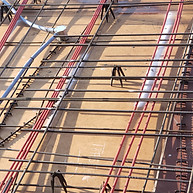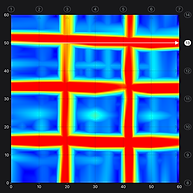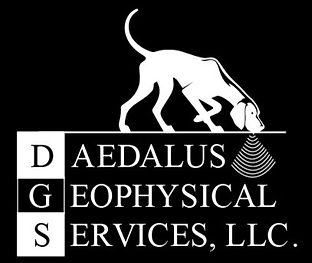Daedalus Geophysical Services, LLC.
Concrete Data,
No Guesswork
Office: 703-447-7028
Email: Info@daedalusgeo.com

About Us
Daedalus Geophysical Services, LLC is a specialized geophysical consulting company focused on providing advanced Ground Penetrating Radar (GPR) scanning solutions for concrete inspection. With a strong emphasis on accuracy, efficiency, and safety, Daedalus delivers high-resolution subsurface imaging to identify rebar, post-tension cables, conduits, and voids within concrete structures.
Whether supporting engineering assessments, construction planning, or structural analysis, the company’s cutting-edge GPR technology and expert interpretation ensure reliable data for informed decision-making, Daedalus Geophysical Services stands at the intersection of innovation and precision in the field of non-destructive testing.
In Greek mythology, Daedalus was a gifted inventor and architect whose name is synonymous with skill, intelligence, and the pursuit of knowledge. At DGS, we strive to be a model example of those traits.
Where You'll Find Us
Daedalus Geophysical Services, LLC provides Ground Penetrating Radar (GPR) services for concrete inspection across a broad region encompassing the Washington, DC Metropolitan Area, including Northern Virginia, the Baltimore Metropolitan Area, and extending south to Richmond, Virginia. The company’s geographic coverage also reaches westward into Eastern West Virginia, enabling Daedalus to support clients throughout a wide range of settings within the Mid-Atlantic region. This expansive service area ensures reliable and accessible concrete inspection solutions using advanced GPR technology anywhere our clients needs us.

Services
Daedalus Geophysical Services, LLC provides expert GPR scanning solutions for safe, accurate subsurface analysis.
We deliver reliable, non-destructive results you can trust.

Concrete/Structural Analysis
Accurately locate rebar, post-tension cables, electrical conduits, and potential voids or defects within slabs, walls, and columns. GPR scanning helps ensure structural integrity, supports safe cutting or coring, and aids in quality control during construction or renovation projects. It’s a fast, reliable, and cost-effective solution for assessing concrete without damaging the material.

3D GPR Mapping
An advanced Ground Penetrating Radar (GPR) technique that produces high-resolution 3D images of features within concrete. By scanning in a grid pattern, 3D GPR accurately maps rebar, mesh, and post-tension cables at various depths and angles. This improves precision in detecting spacing, depth, and alignment, making it ideal for structural assessments, design verification, and safe cutting or coring. The 3D maps give engineers and contractors a clear view of subsurface elements, reducing risk and aiding project planning.

Detect Voids & Delamination
Ground Penetrating Radar (GPR) is a non-invasive method for detecting hidden gaps, air pockets, or separations in concrete or subsurface materials. These issues, often caused by poor construction, material failure, or environmental wear, can weaken structural integrity. GPR identifies such anomalies early by sending radar signals into the material and analyzing the reflections, enabling accurate assessment and targeted repairs to prevent costly damage and ensure long-term safety.

How GPR Works
Ground Penetrating Radar (GPR) works by sending high-frequency radio waves into a surface—like concrete—and measuring how the waves bounce back. When these waves hit something different inside the concrete, such as metal rebar, cables, or air pockets, part of the signal is reflected back to the surface. A sensor picks up these reflections and uses the time it takes for the signal to return to figure out how deep and where the object is located. The results are displayed as images or data that show what's hidden inside the concrete, helping inspectors find problems or avoid hitting anything when cutting or drilling.
GPR offers a fast, accurate, and non-destructive way to inspect concrete without the need for cutting, coring, or drilling. By using electromagnetic pulses to detect changes in material composition beneath the surface, GPR reveals critical details such as the location of rebar, conduits, post-tension cables, voids, and cracks. This allows engineers and contractors to plan with confidence, avoid damaging embedded components, and ensure structural integrity.
Benefits include:
-
Enhanced Safety: Prevents accidental strikes on live electrical conduits or structural reinforcements.
-
Time Savings: Immediate, on-site results speed up decision-making and reduce project delays.
-
Cost Efficiency: Minimizes rework, repairs, and potential liability from structural damage.
-
Structural Insight: Detects hidden flaws like voids or delamination, which are often invisible from the surface.
-
Regulatory Compliance: Helps meet safety and quality standards required in modern construction.
Whether you're assessing an existing structure or planning modifications, GPR delivers the reliable subsurface data needed to move forward with precision and peace of mind.

Daedalus Geophysical Services, LLC, your new partner for expert Ground Penetrating Radar (GPR) concrete inspection. Whether you're looking to assess concrete structures, locate embedded elements like rebar and conduits, or determine slab thickness, our cutting-edge GPR technology provides non-destructive insights with precision. We're here to help you make informed decisions. Please feel free to reach out to us for a customized quote for your project, to schedule our services, or even if you simply have questions about how Ground Penetrating Radar works and how it can benefit your specific concrete inspection needs. We look forward to hearing from you!
Office: 703-447-7028
Email: Info@daedalusgeo.com
